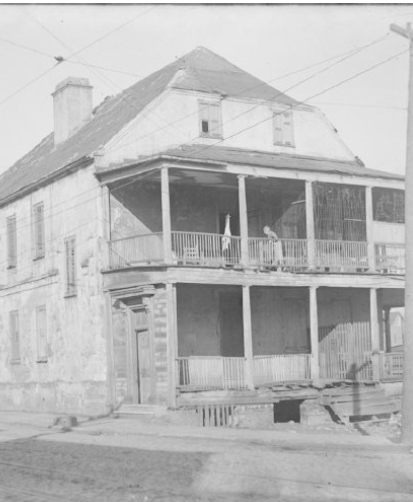THE HENRY LAURENS HOUSE
One of America’s founding fathers and John Hancock’s successor as president of the Second Continental Congress, Henry Laurens, made his fortune exporting rice, indigo, shipbuilding supplies and deerskins, while importing wine, rum, sugar and enslaved people.
Privately, Laurens questioned the morality of slavery. Nevertheless, along with his business partners, he became the largest North American slave importer of his day and one of the wealthiest men in the colonies.
Like every young male Charlestonian, Laurens aspired to the elite planter class, eventually acquiring eventually acquiring nearly 20,000 acres along the South Carolina and Georgia coasts.
He also built a grand town house with a magnificent garden at the southeast intersection of East Bay and Laurens streets. In her 1921 book Historic Houses of South Carolina, Harriett Leiding notes the house featured “colonial carvings, marble mantels, set-in book cases, thick walls, secret doors and, on the upper floor, a wonderful ballroom.”
Though no reliable documentation exists, oral tradition claims that upon her death, the body of Laurens’ young daughter (some sources say sister) lay in repose upstairs in the “wonderful ballroom.” As her body lay near an open window, a storm blew up. When cold rain splashed her face, her eyelids fluttered. She then sat up, recovered and lived for many years afterward.
Whether or not the story is true, Laurens did fear being buried alive. In his will, he directed his son “as an indispensable duty that as soon as he conveniently can, after my decease, he cause my body to be wrapped in 12 yards of Tow Cloth and burnt until it be entirely and totally consumed and then collect my bones, deposit them wherever he shall think proper.”
As local tensions with Great Britain grew during the 1760s, Laurens was among those who sought a peaceful resolution, hoping to avoid war and a complete break with England. Perhaps because of his moderate views, an angry mob gathered at his house on Oct. 23 to protest the hated Stamp Act of 1765, a tax that required the purchase of stamps for documents ranging from newspapers to court records, mortgages and playing cards. An untrue rumor had spread that Laurens was hiding the stamps.
Though he prevented protesters from entering his house, where his wife was recuperating from a serious illness, the mob thoroughly ransacked the property’s dependent buildings. Though they found no stamps, they did find enough good wine to keep the protest a rowdy one as they moved on to search the residence of the colony’s Chief Justice.
Eventually, Laurens realized that compromise was not possible and pledged his support to the Patriot cause. Laurens had served as a lieutenant colonel during the French and Indian War in the 1750s and early '60s. By the time the American Revolution began, he was in his 50s and suffering from gout, leading him to serve in a diplomatic role rather than as a soldier.
On a mission to secure funding for the war from the Dutch on Sept. 3, 1780, Laurens was captured off the coast of Newfoundland by the British, becoming the only American ever to be imprisoned in the fabled Tower of London. Fifteen months later he was released in a prisoner exchange for Gen. Charles (Lord) Cornwallis and, along with Benjamin Franklin, John Adams and John Jay, helped develop a truce with Britain in 1783. Ironically, his former business partner in the slave trade, Richard Oswalt, was the principal negotiator for the British.
While Laurens was in Europe, his son John (who has achieved fame as a character in the Broadway musical “Hamilton”) was killed in the Battle of Combahee River in Colleton County — one of the Revolution’s last documented causalities.
The father and son had been close, though their support of slavery differed. John urged the state to arm enslaved men to fight for the American side, thereby earning their freedom. Though he carefully considered his son’s views on the matter, Henry Laurens, like nearly every other White man in the state, opposed it.
Laurens returned to Charleston in 1783 a broken man after his imprisonment and John’s death. Soon after serving as a state elector in the vote selecting George Washington as America’s first president, Laurens retired from public life, rejecting a nomination to serve in the Constitutional Convention of 1789. He spent his last years in relative solitude at his Mepkin Plantation near Cordesville.
Upon his death in 1792, Laurens’ family hesitated to comply with his unorthodox, perhaps even “un-Christian,” request to burn his body. Instead, those enslaved by Laurens gathered around his iron coffin on Mepkin’s bluff overlooking the Cooper River and complied with his request in what is said to be the first documented cremation in America. His ashes were interred in the family cemetery there, next to John’s grave.
In 1914, the grand house at 320 East Bay St. was torn down to make way for a new railroad spur, which was never completed. Today the site is a Philly cheesesteak restaurant and parking lot.

Sources and more information:
Henry Laurens, National Park Service, accessed Sept. 29, 2024.
Henry Laurens: American Statesman, Britannica, accessed Sept. 29, 2024.
Laurens, Henry, South Carolina Encyclopedia, accessed Sept. 29, 2024.
Hull, Thomas N. "It's time to take another look at how we remember 18th-century American envoy Henry Laurens," The Foreign Service Journal, June 2024.
October 1765: A Masked Mob Searches Henry Laurens' House, South Carolina Historical Society
The Papers of Henry Laurens, National Archives, accessed Sept. 29, 2024.

